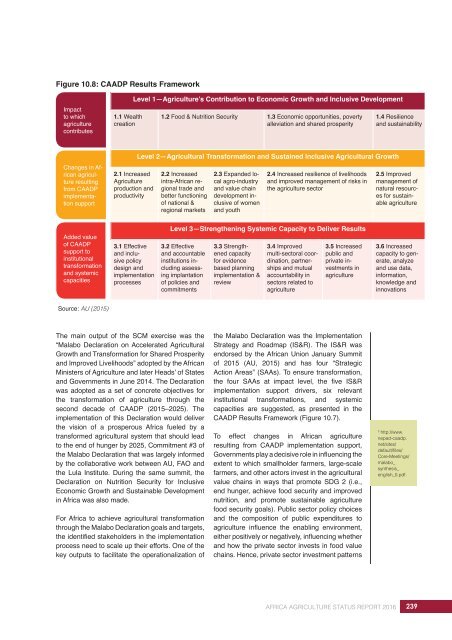AFRICA AGRICULTURE STATUS REPORT 2016
AASR-report_2016-1
AASR-report_2016-1
You also want an ePaper? Increase the reach of your titles
YUMPU automatically turns print PDFs into web optimized ePapers that Google loves.
Figure 10.8: CAADP Results Framework<br />
Impact<br />
to which<br />
agriculture<br />
contributes<br />
1.1 Wealth<br />
creation<br />
Level 1—Agriculture’s Contribution to Economic Growth and Inclusive Development<br />
1.2 Food & Nutrition Security 1.3 Economic opportunities, poverty<br />
alleviation and shared prosperity<br />
1.4 Resilience<br />
and sustainability<br />
Changes in African<br />
agriculture<br />
resulting<br />
from CAADP<br />
implementation<br />
support<br />
2.1 Increased<br />
Agriculture<br />
production and<br />
productivity<br />
Level 2—Agricultural Transformation and Sustained Inclusive Agricultural Growth<br />
2.2 Increased<br />
intra-African regional<br />
trade and<br />
better functioning<br />
of national &<br />
regional markets<br />
2.3 Expanded local<br />
agro-industry<br />
and value chain<br />
development inclusive<br />
of women<br />
and youth<br />
2.4 Increased resilience of livelihoods<br />
and improved management of risks in<br />
the agriculture sector<br />
2.5 Improved<br />
management of<br />
natural resources<br />
for sustainable<br />
agriculture<br />
Added value<br />
of CAADP<br />
support to<br />
institutional<br />
transformation<br />
and systemic<br />
capacities<br />
3.1 Effective<br />
and inclusive<br />
policy<br />
design and<br />
implementation<br />
processes<br />
Level 3—Strengthening Systemic Capacity to Deliver Results<br />
3.2 Effective<br />
and accountable<br />
institutions including<br />
assessing<br />
implantation<br />
of policies and<br />
commitments<br />
3.3 Strengthened<br />
capacity<br />
for evidence<br />
based planning<br />
implementation &<br />
review<br />
3.4 Improved<br />
multi-sectoral coordination,<br />
partnerships<br />
and mutual<br />
accountability in<br />
sectors related to<br />
agriculture<br />
3.5 Increased<br />
public and<br />
private investments<br />
in<br />
agriculture<br />
3.6 Increased<br />
capacity to generate,<br />
analyze<br />
and use data,<br />
information,<br />
knowledge and<br />
innovations<br />
Source: AU (2015)<br />
The main output of the SCM exercise was the<br />
“Malabo Declaration on Accelerated Agricultural<br />
Growth and Transformation for Shared Prosperity<br />
and Improved Livelihoods” adopted by the African<br />
Ministers of Agriculture and later Heads’ of States<br />
and Governments in June 2014. The Declaration<br />
was adopted as a set of concrete objectives for<br />
the transformation of agriculture through the<br />
second decade of CAADP (2015–2025). The<br />
implementation of this Declaration would deliver<br />
the vision of a prosperous Africa fueled by a<br />
transformed agricultural system that should lead<br />
to the end of hunger by 2025, Commitment #3 of<br />
the Malabo Declaration that was largely informed<br />
by the collaborative work between AU, FAO and<br />
the Lula Institute. During the same summit, the<br />
Declaration on Nutrition Security for Inclusive<br />
Economic Growth and Sustainable Development<br />
in Africa was also made.<br />
For Africa to achieve agricultural transformation<br />
through the Malabo Declaration goals and targets,<br />
the identified stakeholders in the implementation<br />
process need to scale up their efforts. One of the<br />
key outputs to facilitate the operationalization of<br />
the Malabo Declaration was the Implementation<br />
Strategy and Roadmap (IS&R). The IS&R was<br />
endorsed by the African Union January Summit<br />
of 2015 (AU, 2015) and has four “Strategic<br />
Action Areas” (SAAs). To ensure transformation,<br />
the four SAAs at impact level, the five IS&R<br />
implementation support drivers, six relevant<br />
institutional transformations, and systemic<br />
capacities are suggested, as presented in the<br />
CAADP Results Framework (Figure 10.7).<br />
To effect changes in African agriculture<br />
resulting from CAADP implementation support,<br />
Governments play a decisive role in influencing the<br />
extent to which smallholder farmers, large-scale<br />
farmers, and other actors invest in the agricultural<br />
value chains in ways that promote SDG 2 (i.e.,<br />
end hunger, achieve food security and improved<br />
nutrition, and promote sustainable agriculture<br />
food security goals). Public sector policy choices<br />
and the composition of public expenditures to<br />
agriculture influence the enabling environment,<br />
either positively or negatively, influencing whether<br />
and how the private sector invests in food value<br />
chains. Hence, private sector investment patterns<br />
3<br />
http://www.<br />
nepad-caadp.<br />
net/sites/<br />
default/files/<br />
Core-Meetings/<br />
malabo_<br />
synthesis_<br />
english_0.pdf.<br />
<strong>AFRICA</strong> <strong>AGRICULTURE</strong> <strong>STATUS</strong> <strong>REPORT</strong> <strong>2016</strong><br />
239


